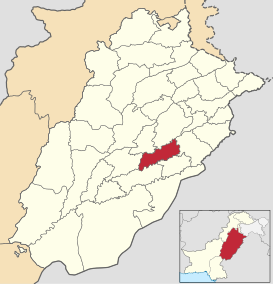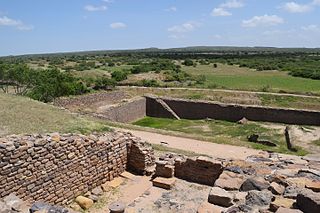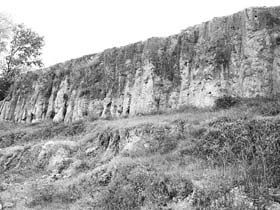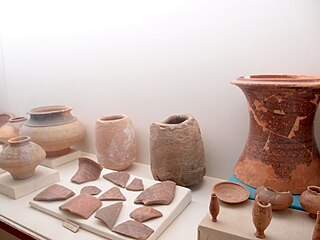
The Cemetery H culture was a Bronze Age culture in the Punjab region in the northern part of the Indian subcontinent, from about 1900 BCE until about 1300 BCE. It was a regional form of the late phase of the Harappan civilisation.

The Indus Valley Civilisation (IVC) was a Bronze Age civilisation in the northwestern regions of South Asia, lasting from 3300 BCE to 1300 BCE, and in its mature form from 2600 BCE to 1900 BCE. Along with ancient Egypt and Mesopotamia it was one of three early civilisations of the region comprising North Africa, West Asia and South Asia, and of the three, the most widespread, its sites spanning an area stretching from northeast Afghanistan, through much of Pakistan, and into western and northwestern India. It flourished in the basins of the Indus River, which flows through the length of Pakistan, and along a system of perennial, mostly monsoon-fed, rivers that once coursed in the vicinity of the seasonal Ghaggar-Hakra river in northwest India and eastern Pakistan.

Rakhigarhi, Rakhi Garhi, is a village in Hisar District in the state of Haryana in India, situated 150 kilometers to the northwest of Delhi. It is the site of a pre-Indus Valley Civilisation settlement going back to about 6500 BCE. Later, it was also part of the mature Indus Valley Civilisation, dating to 2600-1900 BCE. The site is located in the Ghaggar-Hakra river plain, some 27 km from the seasonal Ghaggar river.
Jonathan Mark Kenoyer is an American archaeologist and George F. Dales Jr. and Barbara A. Dales Professor of Anthropology at the University of Wisconsin–Madison. He earned his Bachelor of Arts, Master's, and Doctorate degrees at the University of California, Berkeley, finishing in 1983.

Bahawalpur District is one of the districts of Punjab, Pakistan. Its capital is the city of Bahawalpur. According to the 1998 Census of Pakistan it had a population of 2,433,091, of which 27.01% were urban. Bahawalpur district covers 24,830 km². Approximately two-thirds of the district (16,000 km²) is covered by the Cholistan Desert, which extends into the Thar Desert of India. The district is a major producer of cotton.
Gregory Louis Possehl was a Professor Emeritus of Anthropology at the University of Pennsylvania and curator of the Asian Collections at the University of Pennsylvania Museum of Archaeology and Anthropology. He has been involved in excavations of the Indus Valley Civilization in India and Pakistan since 1964, and is an author of many books and articles on the Indus Civilization and related topics. He received his BA in Anthropology from the University of Washington in 1964, his MA in Anthropology from the University of Washington in 1967, and his PhD in Anthropology from the University of Chicago in 1974. He has conducted major excavations in Gujarat, Rajasthan (Gilund), and in January 2007, began an excavation at the UNESCO World Heritage site of Bat in the Sultanate of Oman.

Sahiwal District, is a district in the Punjab province of Pakistan. In 1998, it had a population of 1,843,194 people, 16.27% of which were in urban areas. Since 2008, Sahiwal District, Okara District, and Pakpattan District have comprised the Sahiwal Division. The city of Sahiwal is the capital of the district and the division.

Dholavira is an archaeological site at Khadirbet in Bhachau Taluka of Kutch District, in the state of Gujarat in western India, which has taken its name from a modern-day village 1 kilometre (0.62 mi) south of it. This village is 165 km (103 mi) from Radhanpur. Also known locally as Kotada timba, the site contains ruins of an ancient Indus Valley Civilization/Harappan city. Dholavira’s location is on the Tropic of Cancer. It is one of the five largest Harappan sites and most prominent archaeological sites in India belonging to the Indus Valley Civilization. It is also considered as having been the grandest of cities of its time. It is located on Khadir bet island in the Kutch Desert Wildlife Sanctuary in the Great Rann of Kutch. The 47 ha quadrangular city lay between two seasonal streams, the Mansar in the north and Manhar in the south. The site was occupied from c.2650 BCE, declining slowly after about 2100 BCE. It was briefly abandoned then reoccupied until c.1450 BCE.

Chanhudaro is an archaeological site belonging to the post-urban Jhukar phase of Indus Valley Civilization. The site is located 130 kilometers (81 mi) south of Mohenjo-daro, in Sindh, Pakistan. The settlement was inhabited between 4000 and 1700 BCE, and is considered to have been a centre for manufacturing carnelian beads. This site is a group of three low mounds that excavations has shown were parts of a single settlement, approximately 5 hectares in size.
Ihsan H. Nadiem is a Pakistani archaeologist, museologist, author and poet.

Tourism in Pakistan is a growing industry. In 2010, Lonely Planet termed Pakistan as being "...tourism's ‘next big thing’ for more years than we care to remember. [But] world media headlines [always] send things off the rails". The country is geographically and ethnically diverse, and has a number of historical and cultural heritage sites. The upsurge in tourism in the past few years has been aided by the Government of Pakistan's recent decision to end mandatory No Objection Certificates for foreign tourists seeking to visit certain parts of the country.
Pakistani architecture is intertwined with the architecture of the broader Indian subcontinent. With the beginning of the Indus civilization around the middle of the 3rd millennium BC, for the first time in the area which encompasses today's Pakistan an advanced urban culture developed with large structural facilities, some of which survive to this day. This was followed by the Gandhara style of Buddhist architecture that borrowed elements from Ancient Greece. These remnants are visible in the Gandhara capital of Taxila.

Bara is a village in Rupnagar District in Punjab, India. The village has mainly two Jatt Sikh surnames Chakkal and Heer and lies on the Rupnagar-Morinda Road at the left bank of a seasonal monsoon rivulet called Budki Nadi, about four kilometers south-west of the city Ropar and 40 km (25 mi) northeast of Chandigarh on National Highway 205 (India) (NH-205). Bara is the site of significant archeological excavations connected with the Indus Valley Civilization. It has some evidence of being home to a culture that was a pre-Harappan strand of the Indus Valley Civilization. Baran and Harappan cultures may have intertwined and coexisted in some places, such as Kotla Nihang Khan, also in modern-day Punjab.
Bara Culture was a culture that emerged in the eastern region of the Indus Valley Civilization around 2000 BCE. It developed in the doab between the Yamuna and Sutlej rivers, hemmed on its eastern periphery by the Shivalik ranges of the lower Himalayas. This territory corresponds to modern-day Punjab, Haryana and Western Uttar Pradesh in North India. Baran culture is believed to have initially developed independently of the Harappan culture branch of the Indus Valley Civilization from a pre-Harappan tradition, although the two cultures later intermingled in locations such as Kotla Nihang Khan & Bara, Punjab. In the conventional timeline demarcations of the Indus Valley Tradition, the Bara culture is usually placed in the Late Harappan period.

Pakistan is home to many archaeological sites dating from Lower Paleolithic period to Mughal empire. The earliest known archaeological findings belong to the Soanian culture from the Soan Valley, near modern-day Islamabad. Soan Valley culture is considered as the best known Palaeolithic culture of Central Asia. Mehrgarh in Balochistan is one of the most important Neolithic sites dating from 7000 BCE to 2000 BCE. The Mehrgarh culture was amongst the first culture in the world to establish agriculture and livestock and live in villages. Mehrgarh civilization lasted for 5000 years till 2000 BCE after which people migrated to other areas, possibly Harappa and Mohenjo-daro. Harappa and Mohenjo-daro are the best known sites from the Indus Valley civilization.

Pakistan contains some of the oldest archaeological discoveries of the world. The country is home to many archaeological sites dating from Lower Paleolithic period to Mughal empire. The earliest known archaeological findings belong to the Soanian culture from the Soan Valley, near modern-day Islamabad. Soan Valley culture is considered as the best known Palaeolithic culture of Central Asia.

Punjab is the second largest province in Pakistan. It is known for its ancient cultural heritage as well as its religious diversity. The lands of Punjab have been home to a number of religions and civilisations. The Indus Valley Civilization once ruled the region and a significant archaeological find was discovered at the ancient city of Harrapa. The Gandhara civilisation was also quite dominant in the northern region of Punjab at the site of Taxila. Several other civilisations such as Greeks, Central Asians, and Persians ruled Punjab leaving a number of sites which still exist today. The arrival of Islam came about during the rule of the Umayyad Caliphate followed by the Ghaznavids. The Mughals took control of the region and ruled its land for several centuries. The mughal heritage remained quite strong in Punjab with a large number of forts, tombs and monuments still intact today. The Durrani Empire ruled the Punjab at the fall of the Mughal Empire for a short period following the rise of the Sikh Empire. The strong control of the Sikhs also lead to a number of sites still remaining intact throughout Punjab. The British Raj took control of the region until the independence.
























